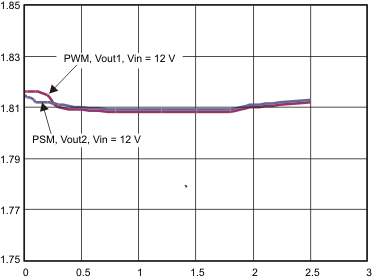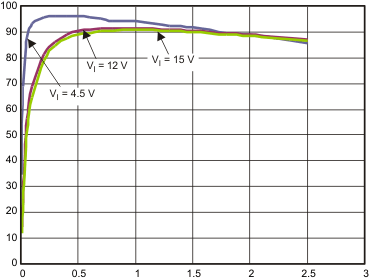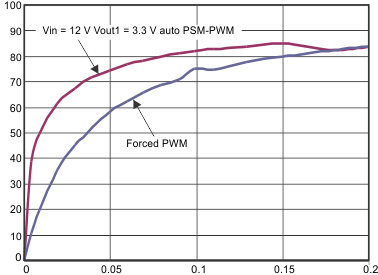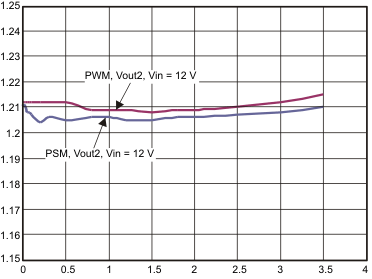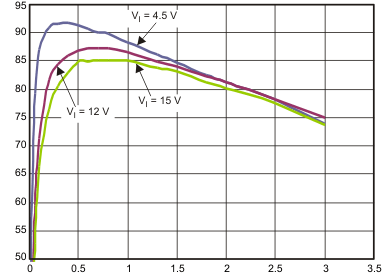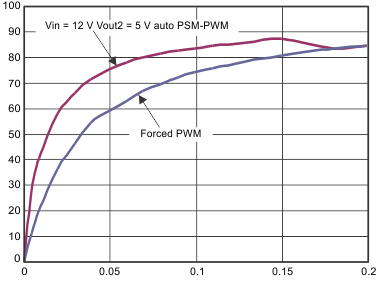| INPUT SUPPLY |
| VIN |
Input Voltage |
VIN1 and VIN2 |
4.5 |
|
18 |
V |
| IDDSDN |
Shutdown |
EN1 = EN2 = 0 V |
|
10 |
|
µA |
| IDDQ_nsw |
Nonswitching quiescent power supply current |
VFB1 = VFB2 = 900 mV, LOW_P = high |
|
1 |
|
mA |
| UVLO |
VIN undervoltage lockout |
Rising VIN |
4 |
4.2 |
4.45 |
V |
| Falling VIN |
3.65 |
3.85 |
4.1 |
| Hysteresis |
|
0.35 |
|
| VCC |
Internal biasing supply |
VCC load current = 0 A, VIN = 12 V |
|
6.25 |
|
V |
| VCC_drop |
VCCLDO Dropout Voltage |
VIN = 5 V, VCC load current = 20 mA |
|
180 |
|
mV |
| IVCC |
VCC current limit |
4.5 V < VIN < 18 V |
|
200 |
|
mA |
| FEEDBACK AND ERROR AMPLIFIER |
| VFB |
Regulated feedback voltage |
VIN = 12 V , VCOMP = 1.2 V, TJ = 25°C |
–1% |
0.8 |
1% |
V |
| VIN = 12 V, VCOMP = 1.2 V, TJ = –40°C to 125°C |
–2% |
0.8 |
2% |
| VLINEREG |
Line regulation: DC |
VIN = 4.5 V to 18 V, IOUT = 1 A |
|
0.5 |
|
%/V |
| VLOADREG |
Load regulation: DC |
IOUT = 10% to 90%, IOUT,MAX |
|
0.4 |
|
%/A |
| Gm_EA |
Error amplifier transconductance |
–2 µA < ICOMP < 2 µA |
|
130 |
|
µs |
| Gm_SRC |
COMP voltage to inductor current Gm |
ILX = 0.5 A |
|
10 |
|
A/V |
| ENABLE, PFM MODE AND SOFT START |
| VEN |
EN1 and EN2 pin threshold |
Rising |
1.55 |
|
|
V |
| Falling |
|
|
0.4 |
| VPSM |
PSM low power mode threshold |
Rising |
1.55 |
|
|
V |
| Falling |
|
|
0.4 |
| ISS |
SS1 and SS2 soft-start charging current |
|
|
5 |
|
µA |
| OSCILLATOR |
| FSW_BK |
Switching frequency |
Set by external resistor ROSC |
0.3 |
|
1.4 |
MHz |
| FSW |
Programmable frequency |
ROSC = 250 kΩ |
0.85 |
1 |
1.15 |
MHz |
| ROSC = 500 kΩ |
425 |
500 |
575 |
kHz |
| PROTECTION |
| ILIMIT1 |
Buck 1 peak inductor current limit |
4.5 V < VIN < 18 V |
|
3.2 |
|
A |
| ILIMIT1_LS1 |
Buck 1 low side MOSFET current limit |
4.5 V < VIN < 18 V |
|
2 |
|
A |
| ILIMIT2 |
Buck 2 peak inductor current limit |
4.5 V < VIN < 18 V |
|
4.1 |
|
A |
| ILIMIT1_LS2 |
Buck 2 low side MOSFET current limit |
4.5 V < VIN < 18 V |
|
2 |
|
A |
| MOSFET ON-RESISTANCES |
| Rdson_HS1 |
On resistance of high side FET on CH1 |
BST1 to LX1 = 6.25 V |
|
120 |
|
mΩ |
| Rdson_LS1 |
On resistance of low side FET on CH1 |
VIN = 12 V |
|
80 |
|
mΩ |
| Rdson_HS2 |
On resistance of high side FET on CH2 |
BST2 to LX2 = 6.25 V |
|
95 |
|
mΩ |
| Rdson_LS2 |
On resistance of low side FET on CH2 |
VIN = 12 V |
|
50 |
|
mΩ |
| Ton_min |
Minimum in time |
|
|
80 |
120 |
ns |
| THERMAL SHUTDOWN |
| TTRIP |
Thermal protection trip point |
Rising temperature |
|
160 |
|
°C |
| THYST |
Thermal protection hysteresis |
|
|
20 |
|
°C |
